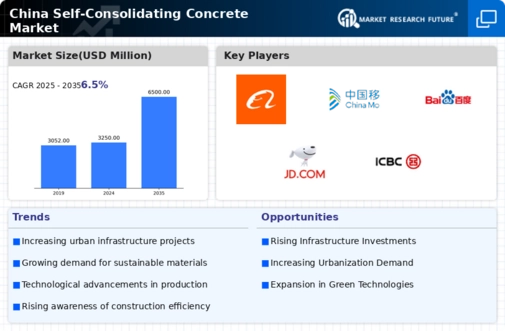Growing Urban Population
China's rapidly growing urban population is a significant driver for the self consolidating-concrete market. With urbanization rates projected to reach 70% by 2030, the demand for housing and commercial spaces is escalating. This urban expansion necessitates the use of advanced construction materials, such as self consolidating concrete, which offers enhanced workability and reduces labor costs. In 2025, the urban population is estimated to exceed 1 billion, creating a substantial market for construction materials. The The self consolidating-concrete market is likely to benefit from this trend. Builders are seeking efficient solutions to meet the increasing demand for residential and commercial infrastructure. Additionally, the material's ability to achieve high strength and durability makes it an attractive option for urban construction projects.
Increased Investment in Green Building
The Increased investment in green building initiatives across China is benefiting the self consolidating-concrete market. As the construction industry shifts towards sustainable practices, there is a growing demand for materials that contribute to energy efficiency and reduced environmental impact. In 2025, investments in green building projects are projected to reach $200 billion, creating a favorable environment for the self consolidating-concrete market. This material's properties, such as reduced permeability and enhanced durability, make it suitable for green building certifications. Furthermore, the emphasis on energy-efficient designs and sustainable construction methods aligns with the broader goals of reducing the carbon footprint of the construction sector. As a result, the self consolidating-concrete market is likely to see increased adoption in green building projects.
Infrastructure Development Initiatives
The The self consolidating-concrete market is experiencing a surge due to extensive infrastructure development initiatives in China. The Chinese government has prioritized infrastructure projects, allocating substantial budgets to enhance urbanization and connectivity. In 2025, the government is expected to invest approximately $1 trillion in infrastructure, which includes roads, bridges, and public transport systems. This investment is likely to increase the demand for self consolidating concrete, known for its superior flowability and ability to fill complex forms without the need for mechanical vibration. As urban areas expand, the need for durable and efficient construction materials becomes paramount, thereby driving the self consolidating-concrete market. Furthermore, the emphasis on high-quality construction materials aligns with the government's goal of improving safety and longevity in infrastructure projects.
Environmental Regulations and Standards
The self consolidating-concrete market in China is being shaped by stringent environmental regulations and standards. The government is implementing policies aimed at reducing carbon emissions and promoting sustainable construction practices. In 2025, it is expected that compliance with these regulations will drive the demand for eco-friendly construction materials, including self consolidating concrete. This material is often formulated with recycled aggregates and supplementary cementitious materials, which can lower the environmental impact of construction projects. As builders seek to adhere to these regulations, the self consolidating-concrete market is likely to expand, offering solutions that align with the growing emphasis on sustainability in the construction sector. The potential for reduced waste and improved resource efficiency further enhances the appeal of self consolidating concrete.
Technological Innovations in Construction
Technological innovations in construction practices are significantly influencing the self consolidating-concrete market in China. The adoption of advanced mixing technologies and automated processes enhances the production efficiency of self consolidating concrete. In 2025, it is anticipated that the market will witness a growth rate of approximately 15% due to these innovations. The integration of smart technologies, such as IoT and AI, in construction processes allows for better quality control and monitoring, ensuring that the self consolidating concrete meets stringent performance standards. As construction companies increasingly embrace these technologies, the demand for self consolidating concrete is likely to rise, driven by the need for high-performance materials that can withstand the challenges of modern construction.
















Leave a Comment